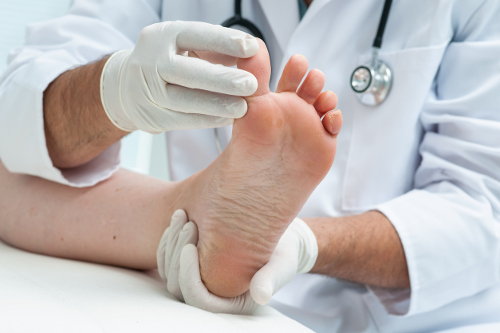If a black toenail is caused by an injury, the resulting spot from broken blood vessels will disappear once your nail grows out.
Is This Black Spot Under My Toenail Cancer?
Dermatologists often see patients concerned about a black spot under their nail. While it could be an indication of skin cancer, there are many other conditions that present this symptom. If you’re concerned about a black spot under your toenail, keep these details in mind and schedule an appointment with your provider right away.
Sign of Skin Cancer
There are different types of skin cancer, each named for the type of skin cell from which they originate. Most skin cancers fall into one of three categories: basal cell carcinoma, squamous cell carcinoma, and melanoma.
A black spot under the nail can indicate a type of melanoma called acral lentiginous melanoma (ALM). These melanomas can appear anywhere on the body, including underneath fingernails and toenails. The sub-type of ALM that affects the nail is called subungual melanoma. Subungual melanoma is rare and typically involves the nail of the big toe or thumb. It often presents as a dark spot or streak in its early stages.
“The most important warning sign of melanoma is a new spot on the skin or a spot that changes in size, shape or color,” says Dr. Alex Jack, a certified dermatologist with U.S. Dermatology Partners Kyle. “A dark spot or streak under the nail should be looked at by a dermatologist right away, especially if you haven’t recently experienced an injury to the area.”
People who have extended or frequent exposure to ultraviolet (UV) rays are at greater risk for melanoma. In fact, 90% of melanoma can be linked to exposure to UV rays. However, there are some cases that occur with little to no exposure, so never assume that you’re not at risk.
Other Skin Conditions
There are many other conditions that can present a black spot under the toenail. While it’s always a good idea to consult with your doctor, keep these skin conditions in mind before making an appointment.
Nail Trauma: If you’ve recently injured the area, the black spot under the nail may be a type of bruise referred to as a subungual hematoma. As a result of an injury, blood pools under the nail leading to discoloration. This type of hematoma is commonly caused by stubbing a toe or from sports trauma. While painful, subungual hematomas rarely need treatment.
Nail Fungus: There are many different symptoms of nail fungus, but discoloration of the nail is usually the first sign. Some nails turn yellow, brown or green. Initially, you may only see a spot of discoloration on the nail. Nail fungus should be diagnosed and treated by a dermatologist right away to protect the integrity of the nail and to prevent it from spreading to others.
Nail Psoriasis: Psoriasis can affect both the fingernails and toenails. In some cases, it can cause the nail to become detached from the nail bed, creating a gap underneath the nail. Bacteria can enter this gap, which then produces a dark green pigment. This is frequently mistaken for melanoma under the nail. Luckily, a dermatologist can provide many treatments for psoriasis to help improve or save the integrity of the nail.
Remember, only a dermatologist can tell you if the black spot is a symptom of these conditions or skin cancer.
Diagnosing the Problem
If you’re concerned about a black spot under the nail, it’s important to schedule an appointment with a dermatologist right away. “Early diagnosis and treatment are critical to increasing the chances of curing cancer,” says Dr. Jack. “Your doctor will want to know when you first noticed the change in your skin, symptoms and your history.”
If your doctor suspects skin cancer, he or she will likely diagnose through a biopsy. The dermatologist will numb the area, then remove all or a portion of the suspicious area. The tissue is usually sent to a lab to be examined under a microscope by a dermatopathologist.
Looking to Visit a Dermatologist?
Black spots under the toenail can be concerning and shouldn’t be ignored. Are you worried about a black spot under your toenail? We can help. To learn more, contact U.S. Dermatology Partners today to make an appointment with one of our board-certified dermatologists. We have multiple locations throughout the country, so fill out our simple online form to get in touch with us. One of our local team members will reach out to you shortly to answer your questions or schedule an appointment for you to visit us soon.
Find a location near me
USE MY CURRENT LOCATION
Black Spot on Toenail: Causes and Treatment Tips
Disclaimer: Results are not guaranteed*** and may vary from person to person***.

With sandal season coming, it is a good time to prepare your feet and toenails for the world to see. If you notice a black spot on toenail, do not worry, as it is probably a result of a minor condition that can be quickly cleared up. Once you know how the spot developed, you can take measures to prevent a future black spot under toenail from appearing.
Black Spot on Toenail: A Closer Look
That unsightly black spot can be a small or large dot that appears on the nail bed of the toe or under the toenail. It could be a black toenail fungus or a collection of dried blood from a recent injury to the toe. The latter may be the result if the area is tender to the touch or causes pain. A fungus condition will see the black spot grow bigger in size.
Letâs learn about the causing factors of these black spots to see if it warrants a visit to the doctorâs office.
Black Spot on Toenail Causes
There are several factors at play behind the black spot under toenail causes. They vary from mild to serious conditions and may require little to no treatment.
1. Injury
As soon as you notice the black spot, try to think of a time you may have injured the toe or caused trauma to the foot. An injury can be from an accident, stubbing the toe on a piece of furniture, or as a result of dropping an object on your foot.
Most toenail injuries require no medical assistance, and an ice compress can be used for any swelling. The black spot will disappear as the nail grows.
2. Runnerâs Toe
We all have those shoes or sneakers we love but may fit too tightly for everyday wear. If you choose to wear snug fitting footwear for activities such as running, a black spot may appear on the nail. It is caused by the compression of the foot and nails.
The obvious treatment is to ensure you wear proper fitting footwear and allow the black spot to disappear on its own.
3. Bacterial Infection
An opening in the skin from a cut or a wound is an invitation for bacteria to set in and cause an infection between the plate and bed of the toenail. The black spots may be the result of the Pseudomonas aeruginosa bacteria. You can distinguish this infection by the sweet odor it produces.
The infection will require a visit to the dermatologist for prevention of further outbreaks. During the treatment, avoid wearing open-toe shoes and walking barefoot outside. Protect the nail bed from the bacteria by cleaning with a soft bristle brush.
4. Fungus Infection
Black spot toenail fungus can be the result of a nail fungus known as onychomycosis. The spot is often seen with brittle toenails with a yellowish hue color.
This condition requires an antifungal treatment or a specialized nail polish with medical components. Surgical nail removal may be recommended in severe cases of fungal infections.
5. Skin Cancer
A black spot on toenail may be the result of acral lentiginous melanoma, or skin cancer. Commonly seen on the big toe, this form of cancer also produces vertical borders.
Black Spots Under Toenail Treatments
For a black spot under toenail treatment, you may be able to use topical, over-the-counter products to cure the underlying cause. There are also gentle products to add to a foot bath to treat the ailment.
If your nail has partially or completely turned black, the fungus infection has set in and destroyed the nail. The toenail will become cracked and brittle and will fall off on its own. We do have preventative measures to treat infected and injured toenails before this happens.
Home Remedies to Treat Black Toenail Fungus
Prevent further complications from black spot under toenail fungus with homemade foot soaks and topical treatments.
1. Tea Tree Oil
Tea tree oil has been used for centuries to treat various conditions as it contains antifungal, antibacterial, anti-inflammatory, and antibiotic properties. These components work together to fight most forms of fungus infections found on the foot.
It is recommended to dilute this strong essential oil with a carrier oil as adding water delays itâs healing effects. Treat the tea tree oil as a nail polish and apply it to the nail bed and surrounding skin several times each day.
2. Apple Cider Vinegar
The natural acidity of apple cider vinegar destroys the fungi behind the infection. Use it as a foot soak in a bath of two parts water to one part vinegar for a 20-minute treatment on a daily basis.
3. Bleach
Household bleach has been used to treat toenail fungus successfully. Those with sensitive skin should not use this form of fungus treatment.
With the risk bleach poses, it is recommended to use a small amount of bleach with a larger amount of warm water for the soak. Only treat the infected toe with the solution and not the entire foot.
To discover a black spot on toenail can raise alarms, both for your health and your vanity. Most cases are caused by a recent mild trauma to the toe and will eventually disappear without taking any action. Conditions such as infections or skin cancer will require medical attention to prevent further complications.
A fungal infection can result in the loss of the nail without treatment. It can also spread to other toes and calls for maintaining dry, clean feet at all times, especially after washing or treating feet with foot baths. It is best advised to check your toenails every day for any signs of trauma or infection.
Black Toenail
We include products we think are useful for our readers. If you buy through links on this page, we may earn a small commission Here’s our process.
How we vet brands and products
Healthline only shows you brands and products that we stand behind.
- Evaluate ingredients and composition: Do they have the potential to cause harm?
- Fact-check all health claims: Do they align with the current body of scientific evidence?
- Assess the brand: Does it operate with integrity and adhere to industry best practices?
What makes a toenail turn black?
Toenails are naturally white in color. Sometimes discolorations can occur from nail polish, nutritional deficiencies, infection, or trauma. Black toenails are attributed to a variety of causes, some of which resolve on their own. If your nail doesn’t get better, you’ll need to see your doctor to rule out a more serious cause of black toenail.
A black toenail may be caused by:
- An underlying medical condition: This may include anemia, diabetes, heart disease, or kidney disease.
- Fungal infections: While these often look white or yellow, fungal infections can sometimes cause black toenails from debris buildup. Your toenails are especially vulnerable to fungal infections because they thrive on moist and warm environments.
- Melanoma: This is the most serious type of skin cancer, which often appears as a dark brown misshapen spot. Such spots can also occur underneath nail beds.
- Trauma: Usually caused by an injury, trauma to the toenail can cause the blood vessels beneath a nail to break. The resulting bleeding underneath the nail appears black.
A black toenail doesn’t necessarily require a doctor’s visit — the need for medical treatment depends on the initial cause. Knowing the cause can help you make this decision. On the flipside, if you don’t know the cause, it’s a good idea to see your doctor just in case your black toenail is a sign of a serious medical condition.
Not all cases of toenail fungus require a doctor’s visit. However, if you also have diabetes, you should see your doctor for treatment.
A dermatologist can also help diagnose and treat black toenail. You’ll need to see a dermatologist if you suspect melanoma. However, if your black toenail is caused by another underlying health issue, such as diabetes, then you’ll also need to see your primary doctor to treat the cause.
Any black toenail that doesn’t go away should be looked at by a doctor. If you’re concerned about your black toenail and don’t already have a dermatologist, you can view doctors in your area through the Healthline FindCare tool.
Toenail fungus that’s left untreated can spread throughout your feet and other parts of your body. It can also cause permanent nail damage.
Complications can also arise from melanoma in the toenail that’s mistaken for trauma-induced black toenail. It’s important to see your doctor if you notice any black spots that might be spreading throughout the nail, or if they don’t go away despite your toenail growing out.
Fungal infections of the toes are relatively treatable at home when caught early. Over-the-counter ointments, creams, and polishes are usually effective. Severe cases may require a prescription antifungal treatment.
If a black toenail is caused by an injury, the resulting spot from broken blood vessels will disappear once your nail grows out.
Black toenail caused by trauma from an injury usually resolves on its own without treatment. However, if your toenail grows out and it still appears black, then the symptoms might be related to another underlying cause.
Toenail discoloration related to diabetes and other health conditions requires treatment for the underlying causes.






